Top speed 941 km/h Wingspan 40 m Weight 44,660 kg Manufacturer Boeing | Range 8,334 km Length 42 m Engine type Pratt & Whitney JT3D | |
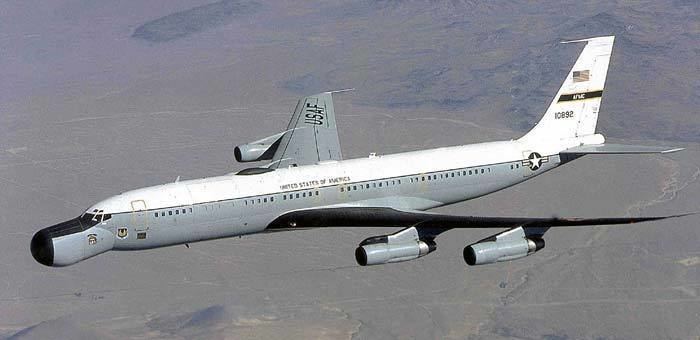 | ||
Boeing ec 135 aria wright patterson museum
The Boeing EC-135 was a command and control version of the Boeing C-135 Stratolifter. Modified for the Operation Looking Glass mission, during the Cold War, EC-135 were airborne 24 hours a day to serve as flying command platforms for the military in the event of nuclear war. The EC-135N variant served as a tracking aircraft for the Apollo program.
Contents
- Boeing ec 135 aria wright patterson museum
- Boeing ec 135e aria
- Advanced Range Instrumentation Aircraft
- Looking Glass
- Silk Purse
- Scope Light
- Blue Eagle
- Nightwatch
- USCENTCOM Support
- Variant summary
- Accidents
- Aircraft on display
- References
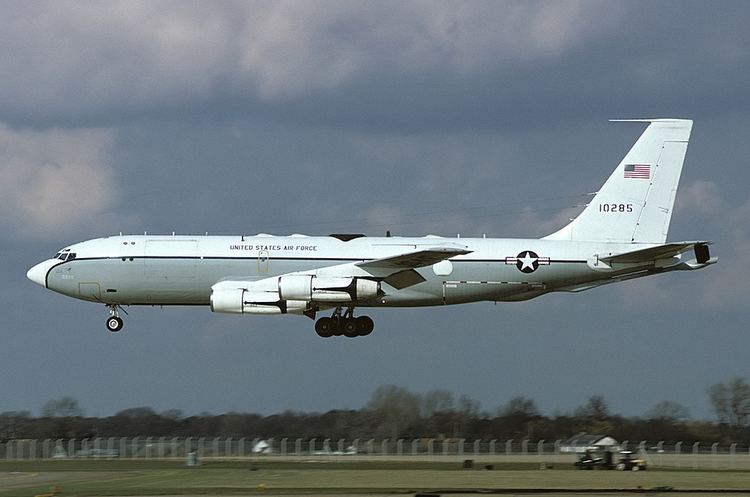
Boeing ec 135e aria
Advanced Range Instrumentation Aircraft
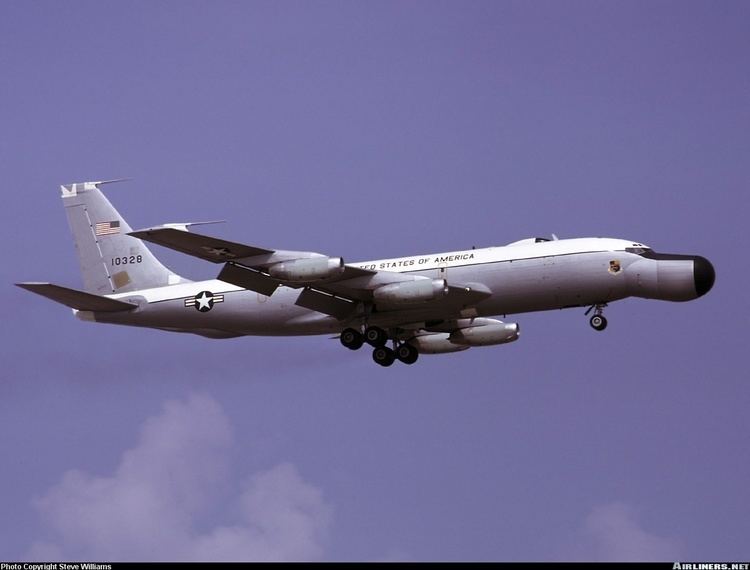
The Advanced Range Instrumentation Aircraft are EC-135Bs, modified C-135B cargo aircraft and EC-18B (former American Airlines 707-320) passenger aircraft that provided tracking and telemetry information to support the US space program in the late 1960s and early 1970s.
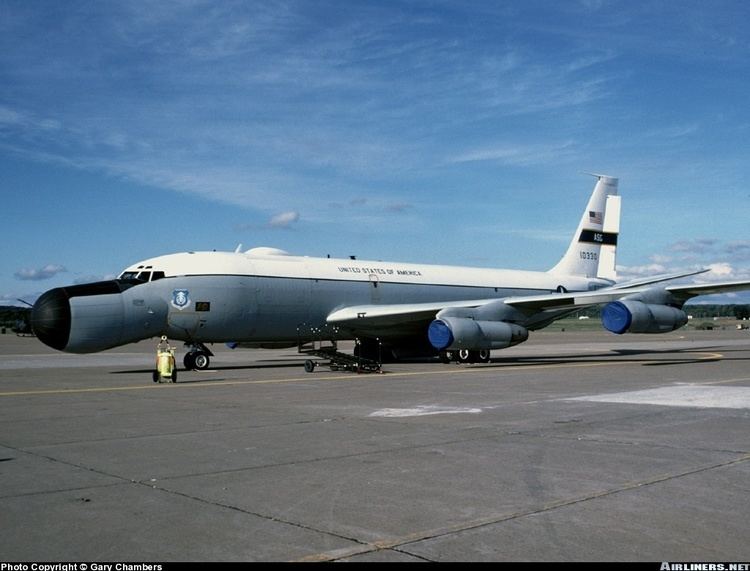
During the early 1960s, NASA and the Department of Defense (DoD) needed a very mobile tracking and telemetry platform to support the Apollo space program and other unmanned space flight operations. In a joint project, NASA and the DoD contracted with the McDonnell Douglas and the Bendix Corporations to modify eight Boeing C-135 Stratolifter cargo aircraft into EC-135N Apollo / Range Instrumentation Aircraft (A/RIA). Equipped with a steerable seven-foot antenna dish in its distinctive "Droop Snoot" or "Snoopy Nose", the EC-135N A/RIA became operational in January 1968, and was often known as the "Jimmy Durante" of the Air Force. The Air Force Eastern Test Range (AFETR) at Patrick AFB, Florida, maintained and operated the A/RIA until the end of the Apollo program in 1972, when the USAF renamed it the Advanced Range Instrumentation Aircraft (ARIA).
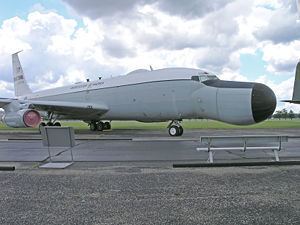
Since Patrick AFB was located, literally, on the Atlantic Ocean, salt water and salt air-induced corrosion issues and associated aircraft maintenance challenges were problematic for the ARIA while based there. Transferred to the 4950th Test Wing at Wright-Patterson AFB, Ohio, in December 1975 as part of an overall consolidation of large test and evaluation aircraft, the ARIA fleet underwent numerous conversions, including a re-engining that changed the EC-135N to the EC-135E. In 1994, the ARIA fleet relocated again to Edwards AFB, California, as part of the 412th Test Wing. However, taskings for the ARIA dwindled because of high costs and improved satellite technology, and the USAF transferred the aircraft to other programs such as E-8 J-STARS.
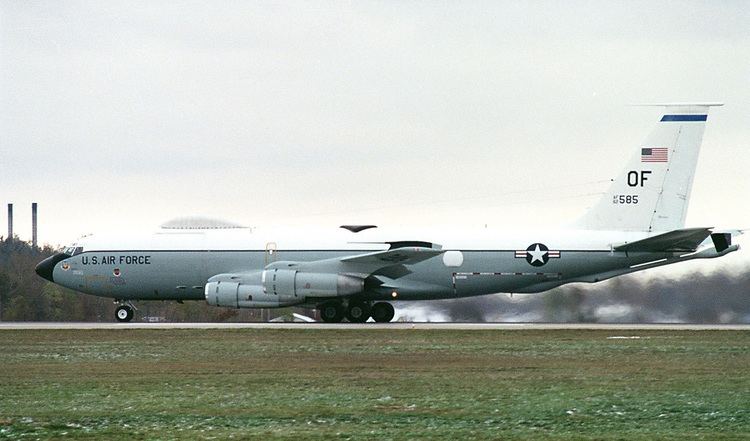
Over its thirty-two year career, the ARIA supported the United States space program, gathered telemetry, verified international treaties, and supported cruise missile, ballistic missile defense tests, and the Space Shuttle.
Looking Glass
Officially known as "Operation Looking Glass", at least 11 EC-135C command post aircraft were provided to the Commander in Chief, Strategic Air Command (CINCSAC), and were based at various locations throughout the United States and worldwide. Operations began in 1961 with the 34th Air Refueling Squadron at Offutt Air Force Base, Nebraska, initially using EC-135As until the dedicated EC-135Cs entered service in 1963. Other Offutt-based units included the 38th Strategic Reconnaissance Squadron (1966–1970), the 2d Airborne Command and Control Squadron (1970–1994), and the 7th Airborne Command and Control Squadron (1994–1998). Other units operating the Looking Glass mission included the following:
Other EC-135 aircraft (including EC-135A, G, and L models) supporting the Looking Glass missions (communications relay and Minuteman airborne missile launch centers) were flown by the 906th Air Refueling Squadron at Minot Air Force Base, North Dakota (1963–1970)1, the 70th Air Refueling Squadron at Grissom AFB (1975–1993), and the 301st Air Refueling Squadron at Lockbourne Air Force Base, Ohio (1963–1970). All aircraft have been retired or repurposed.
The U.S. nuclear strategy depends on its ability to command, control, and communicate with its nuclear forces under all conditions. An essential element of that ability is Looking Glass; its crew and staff ensure there is always an aircraft ready to direct bombers and missiles from the air should ground-based command centers be destroyed or rendered inoperable. Looking Glass is intended to guarantee that U.S. strategic forces will act only in the manner dictated by the President. It took the nickname "Looking Glass" because the mission mirrored ground-based command, control, and communications. Besides being the program name, "Looking Glass" is the official name for the "C" model aircraft of the EC-135. It has a crew of at least 15, including at least one or more general officers.
The Strategic Air Command (SAC) began the Looking Glass mission on February 3, 1961 and Looking Glass aircraft were continuously airborne 24 hours a day for over 29 years, accumulating more than 281,000 accident-free flying hours. On July 24, 1990, "The Glass" ceased continuous airborne alert, but remained on ground or airborne alert 24 hours a day. The EC-135A flew the Command Post mission until EC-135C were delivered starting in 1963. The aircraft were delivered to Offutt AFB and as well as one aircraft to each of the Stateside Numbered Air Force Headquarters - Second Air Force at Barksdale AFB, LA; Eighth Air Force at Westover AFB, MA; and Fifteenth Air Force at March AFB CA. EC-135s flew all the missions except one, on March 4, 1980, when an E-4B was tested on an operational mission, flying a double sortie as the replacement aircraft could not launch due to weather. About a week after the flight, Washington deleted the funds for additional E-4 aircraft.
On June 1, 1992, SAC was inactivated and replaced by the United States Strategic Command, which now controls the Looking Glass. On October 1, 1998, the Navy's E-6 Mercury TACAMO replaced the USAF's EC-135C in the Looking Glass mission. One former Looking Glass aircraft remains in service as a WC-135C Constant Phoenix.
Silk Purse
Operation Silk Purse program provided four EC-135H command post aircraft to the Commander, U.S. European Command (USEUCOM), which were based at RAF Mildenhall in the United Kingdom. Flown by the 10th Airborne Command and Control Squadron 1970-87. Onboard secure/non-secure communications and avionics equipment was maintained by the 513th Avionics Maintenance Squadron. Aircraft S/Ns 61-0282, 285, 286 and 291.
Scope Light
Operation Scope Light provided five EC-135J/P command post aircraft to the Commander in Chief, U.S. Atlantic Command (CINCLANT), which were based at Langley AFB, VA. Operated by the 6th Airborne Command and Control Squadron 1972-92.
Blue Eagle
Operation Blue Eagle provided five EC-135J/P command post aircraft to the Commander in Chief, U.S. Pacific Command (USCINCPAC), which were based at Hickam AFB, HI. Operated by the 9th Airborne Command and Control Squadron 1969-92. Communications, secure/unsecure voice and teletype, handled by the 1957th Communications Group, Hickam AFB, HI (1969-1992)
"Upkeep" was the call sign for the EC135 flying in southeast Asia during 1969 to 1971, based out of Hickam AFB Hawaii. It was under the direction of PACAF of which 5th AF in Fuchu AS, Tokyo Japan handled their voice communications both unsecure and secure. <1956 Comm Gp USAF 1969 to 1971>
Blue Eagle was formed in 1965 and started 24/7 operation in October 1965 and continued until disbanded in 1992 I believe.
I was the first enlisted man assigned to the CINCPAC AIRBORNE COMMAND POST in June 1965 as Emergency Action NCO.
Bob Junkelman Msgt, USAF Retired.
Nightwatch
Operation Nightwatch provided three EC-135J command post aircraft to the President of the United States which were based at Andrews AFB, MD. All three aircraft were transferred to other ABNCP missions.
Nightwatch was initiated in the mid-1960s utilizing the three EC-135J aircraft, modified from KC-135Bs, as command post aircraft. The three Nightwatch aircraft were ready to fly the President and the National Command Authority (NCA) out of Washington in the event of a nuclear attack. The E-4 aircraft (a modified Boeing 747-200) came on line with the Nightwatch program in 1974 replacing the EC-135s on this mission.
USCENTCOM Support
The 310th Airlift Squadron, part of the 6th Air Mobility Wing at MacDill AFB, Florida, operated two NKC-135s that were reconfigured as EC-135Y aircraft from 1989 to 2003 as executive transport and command & control platforms to support the Commander, United States Central Command. These aircraft have since been replaced with three C-37A Gulfstream V aircraft.
